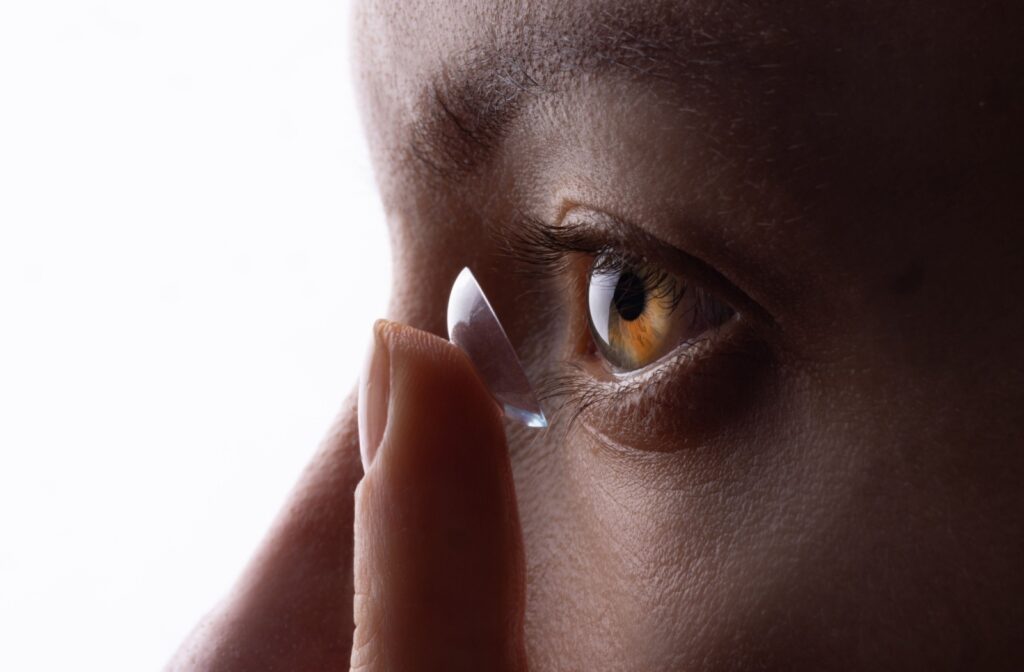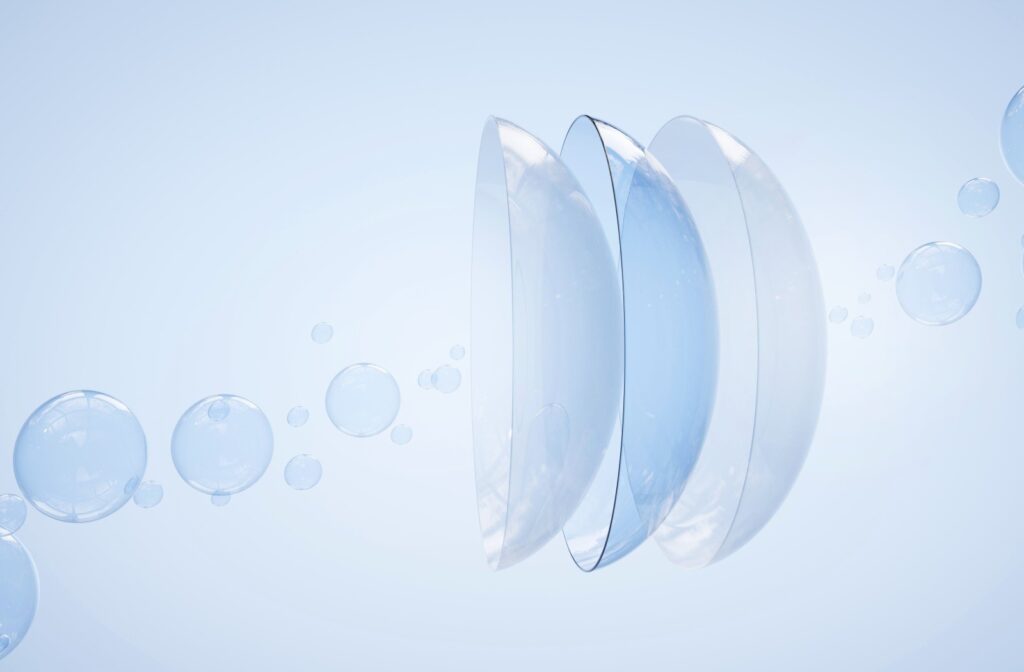Living with keratoconus can present unique vision challenges. Standard glasses may not fully correct your sight, and traditional soft contacts often don’t fit well on an irregularly shaped cornea.
However, many people with keratoconus find success with specialty lens options like scleral lenses. With the right guidance and a bit of practice, you can adapt to your new lenses and enjoy a new level of visual freedom.
Your First Step: The Custom Lens Fitting Process
Your journey with keratoconus contact lenses begins with a contact lens fitting. This helps ensure that you get the clearest vision and best comfort possible.
What to Expect at Your Exam
Your eye doctor will perform a few extra steps beyond a typical eye exam. Using a technique called corneal topography, they’ll map the surface of your cornea to create a detailed, 3D picture of its shape. This allows them to choose a lens type that will work best for you.
Why a Custom Fit Matters for Keratoconus
Because keratoconus causes the cornea to have an irregular shape, it’s especially important that your lenses fit. A custom-fit scleral lens, for instance, vaults over the cornea, creating a smooth surface for light to focus correctly. This is key to correcting the distorted vision caused by keratoconus.
Master the Basics: Insertion & Removal
At first, putting in and taking out your lenses might feel a bit strange. However, with a little practice, it will quickly become a natural part of your daily routine.
A Step-by-Step Guide to Put Your Lenses In
- Wash your hands with soap and water, then dry them with a lint-free towel. This helps keep your contact lenses clean and helps avoid infection.
- Place the lens on the tip of your index finger.
- Use your other hand to hold your upper eyelid open.
- Pull down your lower eyelid with the middle finger of your inserting hand.
- Look straight ahead and gently place the lens on your eye.
- Slowly release your eyelids and blink.
How to Take Your Lenses Out Safely
Your optometrist will show you the best technique for your specific type of lens—whether it’s a soft lens, RGP, hybrid, or scleral lens. Many patients appreciate the benefits of scleral lenses for keratoconus due to their stability and comfort. Always follow your optometrist’s instructions to avoid irritating your eye. Some lenses require a small tool for removal, while others can be removed with your fingers.
Relax & Be Patient
Most people feel nervous at first. It’s okay to take your time and go at your own pace. If you feel frustrated, take a break and try again in a few minutes.
Your New Daily Routine: Lens Care & Hygiene

Keeping your lenses clean is one of the most important things you can do for your eye health. Following proper contact lens care guidelines helps prevent eye infections and keeps your lenses comfortable to wear. A consistent routine makes all the difference.
Clean Lenses, Clean Hands & A Clean Case
This simple rule is your key to success. Always wash your hands before handling your lenses. Clean your lenses every time you take them out, and care for your case as directed by your eye doctor.
Use the Right Solution
Your eye doctor will recommend a cleaning and disinfecting solution that works with your lenses. Don’t switch brands without asking first. Some solutions aren’t compatible with certain lens materials.
Replace Your Case Regularly
Your lens case can collect germs over time. It’s a good habit to replace it every one to three months. After you put your lenses in each morning, rinse the case with fresh solution and let it air-dry upside down. This is part of learning how to store contact lenses safely.
The Adjustment Period: What to Expect
It takes time for your eyes to get used to wearing contact lenses. It’s normal to be aware of them in your eyes for the first few days. This feeling should fade as you adapt to them.
How Long Does It Take to Adjust?
Everyone is different, so the adjustment period can vary. Some people feel completely comfortable within a few hours, while others may take a week or two. Always follow the wear schedule that your optometrist recommends.
Manage Mild Discomfort or Blurriness
Blurriness can sometimes arise as your eyes adjust to new lenses, but it should clear up quickly. If you experience persistent discomfort, including unusual eye pain, redness, or blurry vision, take your lenses out. Then connect with your eye doctor for guidance.
Stay Hydrated for Better Comfort
Drinking plenty of water helps keep your eyes—and your contact lenses—from feeling dry. If dryness is a persistent issue, your eye doctor may recommend dry eye therapy to improve your comfort. They may also recommend rewetting drops that are safe to use with your type of lenses. This can improve comfort throughout the day.
Long-Term Success & Professional Support
Following your prescribed wear schedule and developing good habits will set you up for success with your new lenses. Think of your optometrist as your partner in your eye health journey. Open communication is key to making sure your lenses continue to work well for you.
Follow Your Recommended Wear Time
Your optometrist will tell you how many hours a day you can safely wear your lenses. In some cases, you may start with a shorter time and slowly build up to the maximum recommended wear time. This helps your eyes adapt comfortably.
What Not to Do With Your Lenses
There are a few important rules to follow to protect your eyes:
- Don’t sleep in your lenses unless they’re specifically approved for overnight wear.
- Don’t rub your eyes, as this can worsen keratoconus.
- Don’t wear a lens that appears damaged or torn.
- Don’t use tap water to clean or store your lenses.
Signs You Need an Adjustment
Get in touch with your eye doctor’s office if you notice any of these signs:
- Sharp pain or ongoing discomfort
- Persistent redness or irritation
- Sudden blurry vision
- Increased sensitivity to light
The Importance of Follow-Up Visits
It’s important to remember that keratoconus can progress over time, which means your lens prescription might need to change, too. Regular follow-up appointments are a key part of all comprehensive eye exams, allowing your doctor to check the fit of your lenses. They can make any adjustments needed to keep your vision clear and comfortable.
Our team at 2020 Eyecare Ohio is here to support you every step of the way. Contact us to schedule your consultation and learn more about keratoconus contact lenses.



